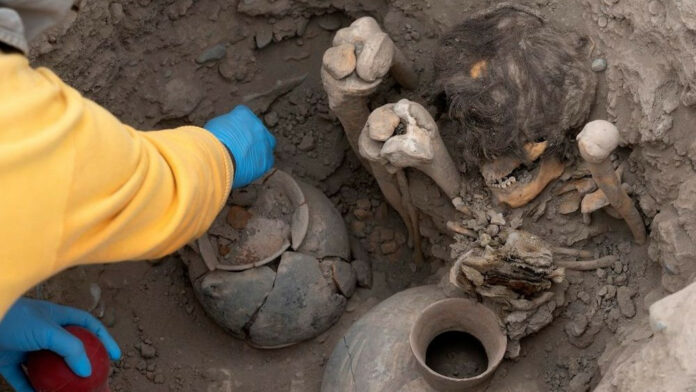In a remarkable archaeological find, a tomb dating back to the Inca era has been uncovered beneath a humble working-class home in Lima, the capital city of Peru. The discovery has sparked excitement among archaeologists and the local community alike.
Tomb Believed to Contain Remains of Ruricancho Elites

The 500-year-old tomb is thought to hold the remains of elites from the Ruricancho society, a civilization that inhabited the region before the rise of the Inca empire. Julio Abanto, the lead archaeologist on the project, revealed that the tomb contains several tightly wrapped bundles, likely containing the remains of the deceased.
Artifacts Indicate High Social Status
Alongside the human remains, the archaeologists discovered an array of artifacts, including ceramics and fine ornaments. These findings suggest that those buried in the tomb held a high social status within the Ruricancho society.
Homeowner Expresses Amazement and Hope

Hipolito Tica, the owner of the house where the tomb was found, expressed his astonishment and the profound significance of the discovery. He hopes that this find will inspire future generations in the working-class neighborhood of San Juan de Lurigancho to develop a deeper appreciation for the rich history that surrounds them.
Mandatory Archaeological Survey Leads to Discovery
The excavations at the site began in May after Tica’s plans for property development triggered a mandatory archaeological survey. The district of Lima where the discovery took place has a history of yielding numerous archaeological finds from cultures that existed before and after the Inca civilization.
Insights into Ancient Civilizations and Shared History
This recent discovery contributes to the growing body of knowledge about the ancient civilizations that once thrived in Peru. It provides valuable insights into the lives of the elites in the Ruricancho society, shedding light on their burial practices, material culture, and social structure.

As archaeologists continue their work at the site, carefully documenting and analyzing the findings, the tomb and its contents will deepen our understanding of the cultural and historical dynamics of the region during the Inca era. Preserving and studying archaeological sites like this offers a glimpse into the past and helps us appreciate the rich heritage of civilizations that came before us, ultimately contributing to a greater understanding of our shared history and the complexities of human societies throughout time.
The Legacy of the Inca Civilization
The Inca civilization, renowned for their wealth in gold and impressive architectural feats like Machu Picchu, once ruled over a vast empire that stretched across western South America. Despite their ultimate defeat at the hands of Spanish invaders in 1532, the legacy of the Inca people continues to captivate scholars and the public alike.
Discoveries Shed Light on Pre-Inca Societies
While the Inca civilization is perhaps the most well-known ancient society in Peru, discoveries like the tomb beneath the working-class home in Lima highlight the importance of studying the cultures that existed before and after the Inca empire. These findings provide a more comprehensive understanding of the region’s history and the diverse societies that shaped it.
The Importance of Preserving Archaeological Sites
The discovery of the Inca-era tomb in Lima underscores the crucial role that archaeological surveys and excavations play in preserving our collective history. By mandating such surveys prior to property development, we can ensure that valuable archaeological sites are not lost to modern construction and that the stories of our ancestors can continue to be told.
Engaging Local Communities in Archaeological Discoveries

The excitement expressed by Hipolito Tica, the homeowner where the tomb was discovered, highlights the importance of engaging local communities in archaeological finds. By fostering a sense of pride and connection to the past, we can encourage the preservation and appreciation of our shared heritage.
Conclusion
The Inca-era tomb discovered beneath a working-class home in Lima, Peru, is a testament to the rich history that lies beneath our feet. As archaeologists continue to study this find and others like it, we gain a deeper understanding of the complex societies that once thrived in the region and the enduring legacy they have left behind. Through the preservation and study of these archaeological sites, we can ensure that the stories of our ancestors continue to be told for generations to come.

